Know the PoE function on RouterBoard
Before making a purchase routerboard, it is advisable to look at the details of the product specifications. Have you seen the features PoE and PoE-In-Out on RouterBoard?, Or when we're looking at - see picture RouterBoard, there are several types of routerboard where there is yellow on one or more interfaces. Such information is an indication that the RouterBoard support PoE feature, a feature that is interesting enough to be implemented on our network.
PoE
Stands for Power Over Ethernet, in other words a method that utilizes twisted pair cable (UTP / STP) as the transmission medium power (power). PoE benefits will be felt when we did the installation of an outdoor wireless devices in the tower. With the PoE, we do not need to withdraw the power cord from the power supply to the tower above the existing router. Examples of installation topology that utilizes PoE devices.
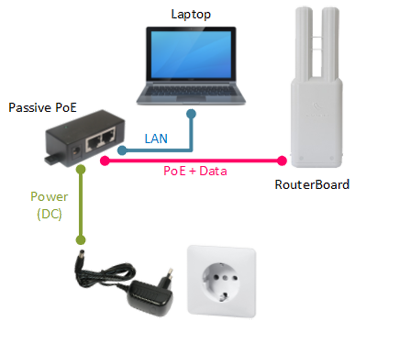
Most of the users of MikroTik already quite familiar with the features PoE-In on RouterBoard.
This means that if RouterBoard support PoE-In, then the routerboard can
receive power from a PoE interface ether without power through the
power jack. RouterBoard that support this feature RouterBoard mostly used for wireless needs.
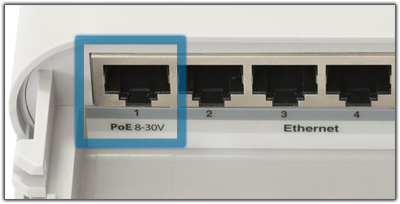
With the PoE-In this feature, technicians no longer need to allocate
power cable to provide power to the RouterBoard, just use PoE to pass
power through UTP cable, UTP cable means will be used to pass data while
skipping the power to RouterBoard. In outdoor wireless package usually includes passive PoE. Shape each passive PoE outdoor wireless packet sometimes differ depending on equipment specifications. Sample images Passive PoE.

On the outside there is usually some text information. For the passive POE port labeled LAN is connected to the local network, can be directly to a computer or to switching. LAN port in passive PoE only serves to pass data. Furthermore, passive PoE port labeled POE on RouterBoard connected to the information contained PoE port (usually ether1). Port is in addition to pass data, also sends power to be used by the RouterBoard. Jack and power port (DC), connect the adapter.
RouterBoard will be lit by using a power supply via a UTP cable from
PoE so they no longer require power from the power jack plugs.
PoE-Out
As we have seen before, some products MikroTik Support PoE output features. This feature serves to provide power supply to the devices connected to interfaces that support PoE-Out.

Examples of products that support PoE Out example RB750UP or Omnitik UPA. Routers that have this feature are usually equipped with different adaptop the usual adapter. Of course a power adapter that has a better capacity. Each - each device has a number of PoE-Put interface that is different - different. It is recommended to see the detailed specifications of each device if you need this feature.
Case suppose we'll plug in some wireless routers in a single tower.
With regular router, then each - each wireless router will need an
adapter and passive PoE, installation topology will be as follows:
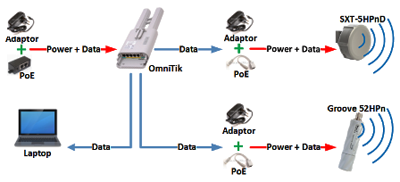
Unlike when we are already use RouterBOARD with PoE feature out, eg Omnitik UPA.
Then the power needs of other wireless routers can be supplied by the
UPA Omnitik without having to add an adapter and PoE for each device. Topology installation will be as follows

PoE-Out can be configured via the command: / interface ethernet poe. Each port can be configured independently.
In the fast ethernet cable, by default Blue and Brown wires will be
used to pass power where the blue wire to the positive voltage while the
brown wire going to miss the negative voltage. If using Winbox, PoE settings can be done by double-click interface, then click the PoE tab.
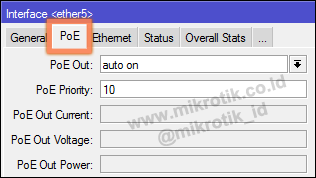
It would appear that some of the parameters can be determined according
to the needs, the following details about pearameter that can be set:
- Auto-on - the router will attempt to detect whether power can be run / not on that port. The router will check using a low voltage, there are barriers ranged from 3kΩ to 26.5kΩ the PoE will be lit.
- Forced-on - Turns off and will make the detection function as PoE ports continuously for no overload and short circuit.
- Off - The function will be switched off and PoE detection will also be turned off. Ethernet port will function properly regular ethernet.
In RouterOS v.6.x if using a long cable to a power source on the router add the following command: / interface ethernet set ether1 poe-poe settings-in-long-cable = yes
PoE Priority
Used to determine the priority of PoE power per port.
The highest priority is 0 and the lowest priority is 99. If there are
two or more interfaces with the same priority then the ethernet port
with the smallest number will automatically have higher priority. For example, ether2 and ether3 have the same priority, and if there is an overload ether3 the PoE will be turned off. The router will check every 6 seconds if ethernet is turned off because the priority could be given the power back.
Safety
To avoid hardware damage due to power, PoE feature equipped with several features.
- Port detection, auto-on mode can be said to be fairly safe mode where the router can malakukan checks whether the device is connected to the port requires and is capable of receiving power properly or not.
- Overload Protection, when Poe-Out run the router will check the occurrence oveload. In case of overload the PoE-Out will be turned off to avoid hardware damage caused by excessive power. PoE controller firmware version 2 allows the distribution of maximum 1 ampere at one port and a maximum of 2.2 amps for a total of all ports.
- Short Circuit Detection, checking is done at the time of the occurrence of short-out on the PoE-enabled. If the router detects the occurrence of short, then all PoE-Out port will be turned off.
For monitoring, simply double-click interface that runs as POE-Out,
then the tab will display information PoE power is distributed on the
port.
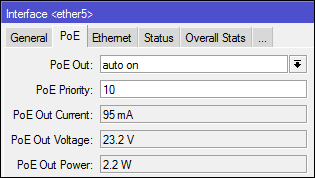
RouterBoard device that supports PoE-Out usually marked with the code
"P" or "i" in the product name, eg Omnitik UPA, RB750UP, RB260GSP,
RB2011UiAS, etc..
Code "P" means all ethernet besides ether1 on RouterbBoard support
PoE-Out, while the product has the code "i" means having a support
Ethernet PoE-Out.
No comments:
Post a Comment